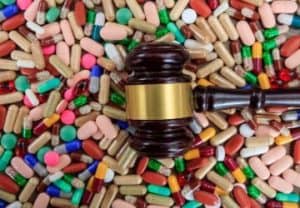Defective Products Attorneys in South Carolina
If you or a loved one have suffered an injury from a defective product, let one of the South Carolina Defective Products Lawyers at the Strom Law Firm help get you the compensation you deserve for your product liability case.
Americans seek medical attention for 30 to 40 million consumer product-related injuries every year, according to the Consumer Product Safety Commission. The cost of these injuries is staggering. The United Nations Conference on Trade and Development estimates these injuries cost U.S. consumers $1 trillion annually. That comes to roughly $2,800 for every person in the United States. Consumer product-related injuries accounted for 44 percent of all nonfatal injuries requiring emergency treatment and 29 percent of all accidental injuries resulting in death in the United States between 2008 and 2010. The CPSC gathers most of its information on product-related injuries from hospitals. However, consumers can also report injuries they have experienced on the agency’s webpage.
Sometimes, injuries and/or damages occur due to a defective product, device, drug, food, or toy. If this happens to you or someone in your family, you may have a defective product claim against the manufacturer or distributor. Every year, thousands of consumers sustain serious injuries from defective products of all kinds. Many of these injuries could have been avoided if the manufacturers or distributors of these products had taken additional steps to ensure consumer safety. Defective products that commonly cause injuries include medical devices, pharmaceuticals, and other defective products such as toys, tools, cars, and automotive parts.
Examples of South Carolina Defective Products
One of the most devastating areas of defective and dangerous products involves toys because children can be seriously and unexpectedly harmed by something intended to bring them joy. According to areport by the Consumer Product Safety Commission, approximately 166,200 children under 15 were treated in the emergency room for toy-related injuries in 2018. Of those, many thousands resulted in hospitalization, and dozens resulted in fatalities.
Some of the most common toys that cause severe injury or even death to children include scooters, rubber balls, stuffed toys, and water toys. Other common toy hazards to consider:
- Toys that contain lead-based paint.
- Toys that contain small pieces which can pose a choking hazard
- Toys that contain long strings or rope may pose a strangulation hazard
During the coronavirus pandemic of 2020, children experienced more injuries due to defective and dangerous products. Injuries caused by skateboards, hoverboards, and scooters increased sharply in the summer of 2020. There was also a rise in injuries caused by household chemicals such as cleaners, detergents, and even contaminated soap.
Many people are injured by pharmaceutical drugs every year. Some of these drugs are heavily marketed and are proving to cause serious long-term adverse health effects. One of the most difficult aspects of medical product liability cases is receiving some degree of cooperation from the doctor, who understands he may face a potential medical malpractice lawsuit. Even if the doctor has no potential liability, he may not want to cooperate in litigation.
Drugs are designed to help bring relief from pain, but at times, a drug that is intended to help causes more injury instead. Sometimes. They can even be fatal. This commonly occurs when a new drug is not adequately tested, when the patient receives a prescription error, or when the drug causes an unexpected side effect.
Drug manufacturers have a responsibility to ensure that the drugs they market for patients’ use do not harm them. Some drugs have dangerous side effects and/or can cause potential long-term health problems. Often, these drugs are subject to defective drug recalls. While the Food and Drug Administration has a part in determining a drug’s safety, ultimately, the manufacturer is liable for injuries suffered.
Defective products should never be put into the hands of any consumer. When product manufacturers negligently or intentionally ignore defects, consumers can suffer injuries such as burns, broken bones, electrocution, amputations, lacerations, and wrongful death. Manufacturers and distributors sell millions of defective tools, toys, appliances, vehicles, and other items to the public every year. These potentially hazardous items can sometimes cause catastrophic injuries, giving victims the right to file civil lawsuits in pursuit of monetary damages.
Another area to consider outside the consumer realm are defective products in the workplace. Injured employees are often limited to workers’ compensation claims against the employer. However, there are additional claims that can be made against manufacturers and distributors of industrial tools and machinery. Poorly designed industrial machinery can lead to devastating injuries to employees who are just doing their jobs and do not fully appreciate the potential dangers. Within seconds, a worker can sustain a head injury, lose a limb, or suffer fatal injuries.
When designing machinery, industry engineers concerned about safety generally implement a basic “design guard, warn” hierarchy. That is likely the best solution if the hazard can be removed through an improved design. If the hazard can not be corrected through design, then guards should be put in place to protect the worker. If that is not possible, then proper warnings should be placed in the appropriate locations, warning the user of potential hazards.
Here are some of the most common workplace hazards:
Explosions/Fires – These can include a defective circuit breaker or machine that overheats that leads to a fire or explosion.
Pinch Points – Where the wheels or conveyors intersect can grab a worker’s arm, hair or loose clothing into moving machinery causing serious if not fatal injuries.
Crush Areas – Places where two parts of machinery intentionally collide, like an industrial press, must have proper protections and warnings for operators.
What is a product liability claim in SC?
A person can bring a product liability claim when they have been injured or sustained damage due to a consumer item that failed to function reasonably safely. This can involve an automobile or car part, a child or baby product or toy, a household appliance, a tool, equipment used in the workplace, a medical device, a drug, or virtually anything else released to the market for public consumption.
When you suffer an injury or illness linked to a defective product or dangerous consumer product, pharmaceutical, or medical device, any lawsuit you file against the manufacturer and others who assist the manufacturer in bringing their product to the marketplace for public consumption will most likely be governed by a fault concept known as “product liability.”
How is a defendant liable if I am injured by a defective product in South Carolina?
These kinds of injury claims we see in defective product liability cases can differ from those from car accidents and other mishaps. In some cases, the injured person does not need to show negligence on the manufacturer’s part. This is known as the concept of strict liability.
The rules of strict liability state that a manufacturer or other party involved in bringing consumer products to market may be strictly liable for an accident under certain circumstances. Strict liability laws typically apply to cases involving pet owners or unreasonably dangerous activities. They can also apply to defective product lawsuits. In these cases, a court may assign liability to one or more defendants even where the plaintiff has no proof that the defendant was negligent or had an intent to harm. The defendant may still be liable for damages under strict liability rules.
Strict product liability laws state that a manufacturer or distributor of a defective product will owe an injured person compensation even if the defendant took some reasonable steps to prevent the defect. In strict product liability cases, it will not matter whether the defendant was negligent. The plaintiff could still receive financial compensation for damages without proof of the defendant’s fault. These strict product liability cases have different burdens of proof than standard civil claims.
What are the elements of proof in a product liability claim in SC?
Typically, in a liability claim, a Plaintiff must prove the existence of a duty, a breach of that duty, and causation of damages. However, some defective product liability lawsuits fall under strict liability and require unique proof. If the plaintiff’s attorney can prove the product contained a manufacturing defect and caused the injury, this will typically be enough to be awarded financial compensation.
Strict product liability claims require the establishment of one of three types of defects:
- Defective Design. A manufacturing plant may create the item perfectly according to the design specifications. However, it could still inflict injury because it was manufactured based on a dangerous design. For example, a coffee cup is designed to be made of materials that won’t insulate from high heat and cause burns simply by handling the cup.
- Manufacturing Defect. Sometimes, an error or mistake in the manufacturing process can alter the product from its original design, causing injuries. Manufacturing defects can occur anytime, from the design stage to product distribution. For example, a coffee cup intended to be made with a certain thickness is made too thin, causing burns because it no longer adequately protects the consumer from the hot liquid inside.
- Marketing Defect. This refers to lapses, mistakes or lack of proper warnings in the marketing of a product. A manufacturer must post instructions or safety warnings somewhere on the item if the product poses non-obvious risks to consumers. Example: A cup that is not designed or manufactured to withstand or protect a consumer from heat must warn that it is not intended for use with hot liquids.
If a plaintiff’s lawyer can demonstrate the item in question contained one of these defects, the rules of product liability will apply to the case. It may not be necessary for the plaintiff’s lawyer to prove the manufacturing company was guilty of negligence or carelessness. It will only be necessary to establish that the plaintiff used the item as the manufacturer intended, that the item contained a defect, and the item caused specific damages.
Some product liability cases do not involve the doctrine of strict liability. Instead, the plaintiff’s attorney may base the claim on negligence, breach of warranty or misrepresentation of facts. A product liability claim based on one of these theories will typically require some evidence of the defendant’s fault, negligence or intent to harm. A defective product liability attorney can help a victim prove this type of case based on the defendant’s actions, some misconduct, or a history of the defendant marketing defective products. All kinds of product liability lawsuits can result in financial compensation for injured consumers in South Carolina if the attorney successfully proves their case.
Whom do I sue if I am injured by a defective product?

What are the different types of defects?
There are three main types of defects in product liability claims:
- Design defects,
- Manufacturing defects, and
- Marketing defects.
Design defects involve products that are unreasonably unsafe in and of themselves, even when they are made exactly as intended. A case based on a design defect challenges the safety of the product line in general rather than the specific product that injured the victim.
Manufacturing defects involve a problem that is unique to a specific item. The defect must have arisen before the item reached the consumer. This occurs most often during making and/or assembling it. It can involve a malfunction of a machine used in the manufacturing process, in human error in safely operating such a machine, or in a failure by a company to create and implement reasonable product safety measures in the manufacturing process to avoid known or knowable issues with a product they are in the business of manufacturing.
Marketing defects, also known as failure to warn, involve a lack of information about the risks posed by a product when it is used in an intended or foreseeable way. In some situations, consumers can also bring claims based on a breach of an express or implied warranty.
How do I establish liability for a South Carolina defective product?
You must show not only that the product had a defect, but that the defect caused your injuries and related costs, called damages. In other words, just the fact that you used the product when you were injured is insufficient evidence to prevail. You must show that, but you would not have been injured by the product defect. Also, it is important that you were using the product in an intended or reasonably foreseeable way at the time. A victim must have sustained actual injuries and quantifiable damages as a result of the defective product.
What must I prove to win my South Carolina defective product liability lawsuit?
The evidence you will need to present in court to win your lawsuit will depend on the particular circumstances of your case. In defective product liability lawsuits, however, claims generally consist of four basic elements.
First, you must prove that you have been injured or suffered some other kind of harm. Unfortunately, a situation where you could have been hurt is not enough – you do not have a claim for being almost injured. Perhaps you used Johnson’s Baby Powder for decades, for example. Simply using the defective product does not, in itself, entitle you to recovery. You cannot sue over harm caused by asbestos in talc products unless you have also suffered some asbestos-related illness.
Second, you must prove that the product in your case was somehow defective in design, manufacture, or in issuing proper warnings or instructions.
Third, you must prove causation. You must show that the defect or failure to warn was the specific cause of your injuries or damages. This often requires the use of experts to provide appropriate scientific proof.
Finally, you must prove that, when you were injured or made ill, you were using the injury-causing product in the manner in which it was intended to be used. Learn more about proving a product liability claim against a manufacturer and others.
How soon do I need to file my claim?
This will depend on the statute of limitations. The statute of limitations may be the same as for other personal injury claims, or it may be specific to certain product liability cases. It often lasts about two years, but it may be as short as one year or as long as four years.
Furthermore, what is known as a discovery rule may extend the statute of limitations until the injured person discovers or reasonably should have discovered that the defect in the product caused their injury. Filing a claim after the statute of limitations has expired will result in the dismissal of a victim’s case in most situations. Moreover, it is very important that you file your case as soon as possible while tangible evidence is still available and the memories of witnesses remain fresh.
What is my South Carolina products liability case worth?
You can ask one of the defective products attorneys at Strom Law Firm to help you calculate the extent of your damages. One group of damages, known as economic damages, compensate a victim for the financial costs related to their injuries. These are relatively objective, such as lost income, medical bills, or property damage as a result of the defect.
The other main group of damages, known as non-economic damages, involves forms of harm that are less easy to calculate, such as pain and suffering.
Further, any defendant that has engaged in intentional misconduct either by not preventing defective products from entering the marketplace or in concealing known defects and dangers from consumers or that otherwise deserves to be punished may be ordered to pay punitive damages. Punitive damages are also meant to deter parties like the defendant from engaging in similar behavior. The threat of large awards from a jury for intentional conduct that damages someone is intended to make potential product liability defendants take more care in designing, manufacturing, and providing appropriate information to maintain safety for people who have purchased their product.
Do I need to hire a product liability lawyer?

What makes a product defective?
- Defective manufacturing
- Inadequate testing
- Food-borne pathogens
- Design defects
- Marketing Misrepresentation
The Defective Products Lawyers at the Strom Law Firm, L.L.C. handle all defective product lawsuits. We have decades of experience in determining all potentially responsible parties, and successfully proving that the defective product caused your injuries. Give us a call today for a free consultation.
Our most common cases include:
- Defective Medical Devices
- Defective Drugs
- Mesothelioma and Asbestos
- Carbon Monoxide
- GM Vehicle Recall
- Talcum Powder Cancer
- Toxic Tort
- Trek Bicycle Recall
- 3M Earplug Lawsuit
- Roundup Cancer Lawsuit
Defective Products Compensation
Consumers harmed by defective products such as drugs, medical devices, or other products may be eligible to receive legal remedies. Such legal remedies or damages may include compensation for medical expenses, lost wages, loss of physical capacity, pain, suffering, and mental anguish. Punitive damages are also available in many jurisdictions to punish defendants in those cases involving particularly egregious conduct that demonstrates a reckless or wanton disregard for the public’s safety.
If you work at a company that manufactures or markets products, such as pharmaceuticals, medical devices, or any other company regulated by the government, and you believe the products are defective, you could have a valid qui tam claim, so reach out to our defective product lawyers today.
Steps to Take After You Learn of a Defective Product
To protect yourself and your family, it is important to know what products have been recalled because they are defective or unsafe. Federal agencies such as the FDA (Food and Drug Administration) and the CPSC (Consumer Product Safety Commission) frequently issue recalls for medical devices, drugs, and products that may be harmful to consumers.
If you have been injured by a defective product, there are important steps you should take. First, ensure that the product is not lost or destroyed. If you do not have access to the product, contact us immediately because we will take the steps necessary to preserve the product before it is destroyed.
Under product liability law, the injured party must prove that the product was defective. Therefore, it is important that the product is inspected by one or more qualified experts to determine the exact nature of the defect and whether that defect caused the harm suffered. If the product is not recovered, the customer may be left with no proof that the product was defective.
Dangerous, defective, improperly labeled, or improperly used products and food are everywhere.
Defective Product Defects
Defective and dangerous products, marketing defects, and manufacturing defects can cause serious injuries, permanent disabilities, and potentially death. Defective products may include consumer products, defective automobiles, defective medical products, and dangerous drugs. Every year, thousands of consumers sustain serious injuries from common household products that are defective. These goods usually seem harmless until an injury occurs. Some examples of defective or unsafe consumer products include automobiles and automotive products, toys and children’s products.
Manufacturing Flaw or Defect
First, a product can be unreasonably dangerous because of a manufacturing defect. A manufacturing defect occurs when the manufacturer fails to make the product in accordance with plans and specifications set forth for the product. This can occur due to improper operation or maintenance of manufacturing equipment or to a human failure in adhering to procedures and standards set forth by regulators, the industry, or the manufacturing company. The design of the product might be flawless. However, one or more items might be deemed dangerously defective because they were made improperly. A plaintiff must also prove that the manufacturing defect itself is causally connected to the injury. Further, it must be proven that the defect existed when the product left the manufacturer’s hands and was unaltered when it caused the injury.
Design Flaw or Defect
Second, a product can be unreasonably dangerous because of a design defect. A design defect occurs when the entire line of products produced by the manufacturer is unreasonably dangerous. Generally, the law requires a balancing test to determine whether the product is unreasonably dangerous. This balancing test weighs the utility of the product against the danger that it poses. In many cases, the plaintiff can offer proof through the use of expert witnesses that a safer alternative design the manufacturer just as easily could have used would have prevented the injury. The court will use this balancing test to weigh the feasibility of that safer alternative design, the cost and availability of certain safety features that could have been added, and the extent to which such modifications would diminish the product’s effectiveness.
Failure to Warn
Finally, a product can be rendered unreasonably dangerous because of inadequate instructions or warnings, also called a failure to warn. Inadequate instructions or warnings occur when the manufacturer or distributor of the product does not provide the consumer or user with sufficient information regarding the danger involved in operating, using, maintaining or cleaning the product. The consumer must be provided with clear and detailed instructions for properly using the product. And the risks and potential dangers of using the product must be communicated to consumers. In order for those instructions or warnings to be considered adequate, they must be conspicuously placed and fully and completely warn the customer of the degree of risk involved in failing to abide by those warnings or instructions.
A lack of adequate instructions or warnings may render a product defective even though it was not otherwise flawed. If it is reasonably foreseeable that people in other countries will have access to purchase and use the product, the warnings may also be required to be in more than one language.
In cases involving inadequate warnings, the presumption is that if the adequate warning had been given, the consumer would have read and heeded that warning. This presumption can only be rebutted with evidence that the consumer had a personal characteristic that would have prevented them from heeding any warning, even if an adequate warning had been provided. Such issues can become complicated and require expert witnesses to give testimony regarding the use of instructions by the average consumer. Pete Strom and the other experienced Defective Product Lawyers at the Strom Law Firm can help you successfully navigate.

these issues.
Let the Strom Law Firm Defective Product Lawyers Fight For You
If you or a loved one has been seriously injured or died as a result of a defective product, food, drug, device, toy, or vehicle, contact the Defective Product Lawyers at the Strom Law Firm, L.L.C. today for a free consultation with one of our South Carolina dangerous product attorneys and South Carolina wrongful death attorneys today to discuss the facts of your case.


















